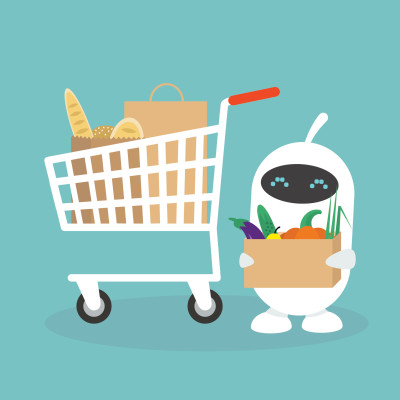
Artificial intelligence is about more than asking Alexa or Siri to turn on the lights at home and add a reminder to the calendar about getting some milk at the store later in the afternoon.
The true power of AI and machine learning is how it can democratize expertise, lowering the barriers to entry for tasks that once could only be performed by a small group of specialists. The result, one day, will be that your self-driving car drops you off at the supermarket, where you will find higher-quality foods available at prices lower than they’ve ever been.
It will happen through the use of machine learning algorithms that absorb a large volume of data, recognize patterns and apply statistical probabilities to choose the course of action most likely to result in a successful outcome.
For example, Google’s famous self-driving car used machine learning to catalog a number of interesting behaviors on the road. Whenever the car’s sensors recognized a garbage truck ahead, vehicles following behind tended to pull suddenly into the next lane to get around it — usually without signaling. So the Google car stored this pattern of behavior and adapted its position and speed to minimize the possibility that these “unexpected” lane changes would cause a collision.
For humans, this is a common defensive driving skill, but replicating this level of awareness in a machine would have been unthinkable just a few years ago. Now, powerful algorithms can conquer the chaos of streets filled with drivers of all skill levels, including those paying more attention to their phones than the road ahead.
Artificial intelligence and agriculture
As amazing as that may be, the application of machine learning to the living fields of agriculture is an order of magnitude more complex. A road network is fixed, with a map that rarely changes and provides a solid foundation for the algorithm to make its decisions.
No matter how calm and peaceful a wind-swept field of wheat might appear to the casual observer, agricultural fields are truly chaotic places. There’s unpredictable weather, changes in soil quality and the ever-present possibility that pests and disease may pay a visit. Conditions in one part of a field may be totally different from another part. As a result, growers never really know until the last day whether they are going to have a successful harvest or not.
The potential for growth in agricultural AI systems is significant.
Take a seed and plant it in a field in Iowa. Then take the exact same seed and plant it in Brazil. The results will almost certainly not be the same, or, if they are, repeat the experiment again and the odds are that the yield of each will be different. That’s because thousands of interrelated variables are at play, from the amount of nutrients in the soil, to whether it’s sunny or cloudy, to rain levels, temperature, the presence of insects and so on.
That’s where machine learning can reap clarity from the chaos. Remote sensors placed in fields perceive the environment as statistical data. Algorithms process this data, adapting and learning to predict a range of outcomes.
Farmers can use these AI algorithms to make better field decisions that increase the chances of a successful harvest. Breeders also can use AI algorithms to make the plants themselves better. The combination of these uses will ultimately drive lower prices at the supermarket.
The democratization of farming expertise
This is a massive a shift in the way things have always been done in agriculture. Farmers have a proud tradition going back centuries of relying on instinct in growing crops. They have an intuition of what’s best based on long experience. It’s not that farmers didn’t want to use computers, it’s that they haven’t been particularly effective. Early machines, with their binary logic, were not well-suited to highly complex and variable field environments.
So a farm’s productivity often depended on having the most experienced growers on hand. But what if we could change that, and make the best decisions and growing techniques available even to novice farmers? This is particularly important for developing nations that might not have access to highly experienced growers.
The rise of precision agriculture has opened the possibility of spreading the benefit of machine expertise far and wide. Remote sensors, satellites and UAVs can gather information 24 hours a day over an entire field. These can monitor plant health, soil condition, temperature, humidity and so on. The amount of data these sensors can generate is overwhelming, but the algorithms of precision agriculture can process and interpret the data in a useful way.
The next big leap will come from deploying true artificial intelligence algorithms that learn from the data and interpret never-before-seen situations, allowing each harvest to become more and more certain. This will reduce wasted effort and lower the cost of growing, with much of the savings passed on to consumers.
AI builds better plants
Machine learning algorithms can also be applied to the centuries-old process of breeding plant varieties better able to resist drought or insect pressures. Breeders have long used conventional methods of selecting the “best” parent plants to create varieties with a more pleasing appearance, longer shelf life and a superior taste. Because of AI’s application in breeding, stronger plants are more likely to make their way to harvest, and yields will continue to increase.
As with farming techniques, machine learning helps with all aspects of the decision-making process of selecting plants and testing new varieties. Algorithms speed the process so that improvements in plant varieties make their way to the fields and the supermarkets faster than ever. This, again, helps lower costs while improving quality.
The potential for growth in agricultural AI systems is significant, and as the algorithms grow smarter, the benefits will continue to be seen every time you check out at the supermarket.


